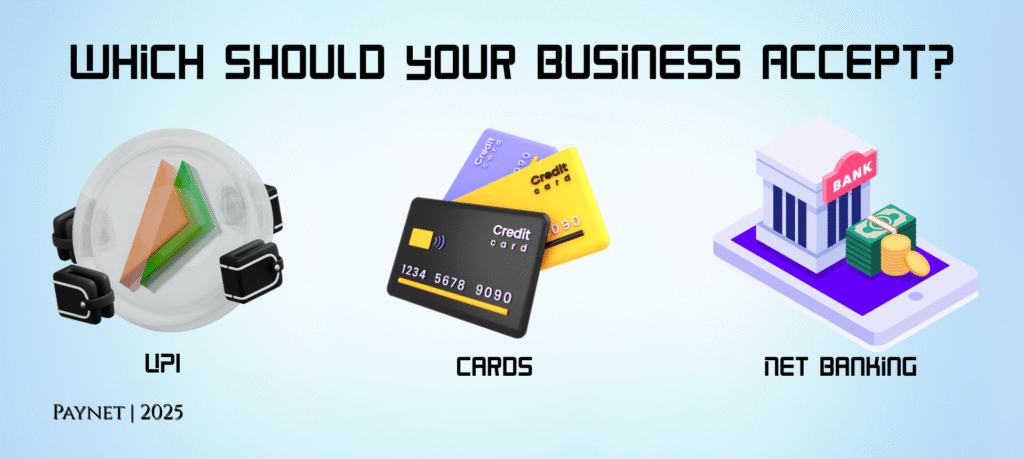User Behavior in Digital Wallet Usage: Insights That Are Shaping the Future of Digital Payments – [Cloned #1447]
Home UPI Growth and Adoption Insights: How India’s Favorite Payment System Is Shaping the Future of Finance Explore UPI growth...

Compare UPI, cards, and net banking for fees, security, and user preference to choose the best payment method for your business.
Choosing the right payment methods can boost conversions, reduce costs, and enhance customer experience. In India, UPI, cards (credit/debit), and net banking dominate digital payments—but each has different fees, security risks, and user adoption rates.
This guide compares all three to help you decide which payment methods to prioritize for your business.
✅ Pros:
✔ Zero MDR (Merchant Discount Rate) for transactions under ₹2,000 (Govt. mandate).
✔ Instant transfers (24/7, including holidays).
✔ Highest adoption (300M+ users, 8B+ monthly transactions).
✔ Low fraud risk (no card details stored).
❌ Cons:
✖ No chargeback protection (disputes are harder to resolve).
✖ Transaction limits (₹1 lakh per payment, ₹2 lakh/day for some merchants).
Best For:
Small businesses (low-cost transactions).
D2C brands & marketplaces (customer preference).
Recurring payments (UPI AutoPay).
✅ Pros:
✔ Higher transaction limits (up to ₹10L+ for premium cards).
✔ Chargeback protection (for fraud/disputes).
✔ Rewards & EMI options (boosts average order value).
❌ Cons:
✖ High MDR fees (1.8-3% + GST per transaction).
✖ OTP friction (abandonment risk).
✖ Card expiry/replacement issues (for subscriptions).
Best For:
E-commerce (high-value purchases).
International sales (Visa/Mastercard global reach).
Luxury brands (EMI options attract buyers).
✅ Pros:
✔ Direct bank transfers (no card/UPI dependency).
✔ No transaction limits (RTGS allows ₹2L+ transfers).
✔ Trusted by older demographics.
❌ Cons:
✖ Slower processing (IMPS: minutes, NEFT: hours).
✖ High failure rates (15-20% due to bank downtime).
✖ No refund automation (manual processing needed).
Best For:
B2B invoices (large amounts).
Older customers (non-UPI users).
High-risk industries (lower fraud risk than cards).
|
Feature
|
UPI
|
Cards
|
Net Banking
|
|---|---|---|---|
|
Fees (MDR)
|
0% (₹2K)
|
1.8-3% + GST
|
₹5-25 per tx
|
|
Speed
|
Instant
|
Instant
|
IMPS: 5 min, NEFT: 2+ hrs
|
|
User Base
|
300M+
|
100M+ (credit)
|
Declining (used mostly for B2B)
|
|
Chargebacks
|
Not applicable
|
Yes (seller protection)
|
No
|
|
Best For
|
P2P, small tx
|
E-commerce, EMI
|
Large B2B tx
|
For E-Commerce:
Prioritize UPI + Cards (cover 90% of buyers).
Use Razorpay/Paytm for easy integration.
For SaaS/Subscriptions:
UPI AutoPay + Cards (avoid net banking for renewals).
For B2B/High-Value Sales:
Net Banking (RTGS) + Corporate Cards.
For International Sales:
Cards (Visa/MC) + PayPal (UPI not accepted globally yet).
UPI International (NRIs paying in INR via foreign banks).
Card tokenization (replaces physical cards for online payments).
CBDCs (Digital Rupee may replace net banking).
Home UPI Growth and Adoption Insights: How India’s Favorite Payment System Is Shaping the Future of Finance Explore UPI growth...
Home User Behavior in Digital Wallet Usage: Insights That Are Shaping the Future of Digital Payments Explore changing user behavior...
Home New Features in UPI and Mobile Wallets 2025: Smarter, Safer & More Seamless Than Ever Explore the latest features...